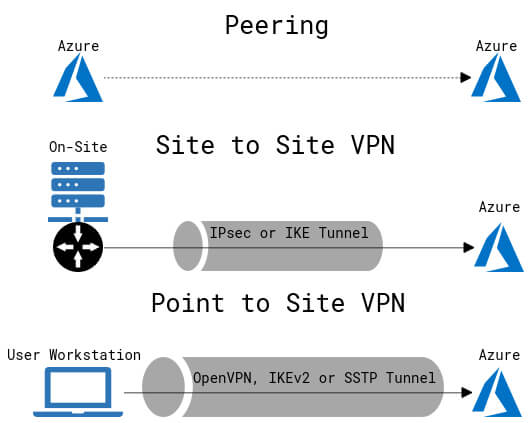Numerous types of VPNs serve companies and individual users around the world. The variety in the market is understandable as business models, security needs, the nature of the confidential data; all of these change from company to company.
Site-to-site VPNs and point-to-site VPNs are almost always confused with each other due to similar security procedures. However, these VPNs are developed for specific functions and you need to understand both and choose wisely. Let’s learn about both of them in detail.
What is a site-to-site VPN?
Some of us are familiar with the name S2S as it’s one of the most popular VPN types, but what is a site to site VPN and how does it work?
Site-to-site Virtual Private Networks (VPNs) securely connect several networks by encrypting information and providing a secure tunnel between them. These networks can be the networks of different branches of a company or those of partnered companies.
These VPN services are mostly used by companies with several physically remote offices whose employees need secure access to the corporate network. They also use this to bring the networks of branches together for a seamless work experience.
Secure links between the networks made with site-to-site VPNs are usually permanent IPsec connections. These connections encrypt all the communication taking place and are always operational.
There are two main types of site-to-site VPNs; intranet and extranet-based. Intranet-based, as you can imagine, encrypt the data transfer between different networks of the same company. These can be remote offices connecting to the headquarters.
Extranet-based site-to-site VPNs secure the connection between different networks on the internet. For example, when you have business partners you need to communicate with, extranet-based VPNs allow you to securely connect with them. You can connect the networks of the two companies without sacrificing the security of your internal network.
What is a point-to-site VPN and how does it work?
Point-to-site VPNs, also known as P2S, initiate a secure gateway from a client computer to a virtual private network. It’s a common way for remote users to access corporate resources from geographically remote locations.
P2S VPNs require setup from the client’s device to initiate the gateway that routes them to the corporate network. Unlike a site-to-site VPN where only the HQ needs a setup, every user of a P2S VPN needs to set up software on their end.
These VPN services allow individual users to connect to various private sites or networks from their computers in a secure way. P2S VPN solutions offer a 1-to-many connection where a single device can set up private VPN gateways with multiple networks or websites that belong to the employee’s company.
Point-to-site VPNs can be set up following the protocols OpenVPN, SSTP (Secure Socket Tunneling Protocol), or IKEv2 VPN. They authenticate requesting users before granting access and then create a private tunnel between their device and the corporate resources.
Point-to-site VPNs are focused on the individual remote users accessing a physically remote corporate data center or headquarters. It’s not usually used by the different branches of a company but remote employees which are increasing in number with the spread of the COVID-19.
You can find more information about P2S explained by Microsoft regarding its security procedures, authentication, and configuration principles.
Site-to-site VPN vs. point-to-site VPN
Let’s talk about their differences. These two VPN types have very particular purposes and they can’t exactly replace each other.
First of all, site-to-site VPN services are more suitable for bigger companies with several offices or networks remote to each other. They are not designed to serve individual members of a company but to companies’ branches or business partners.
P2S VPNs on the other hand, are usually preferred by remote employees of a company meaning that it is set up on a single device, point, and grant access to corporate resources.
Secondly, site-to-site VPNs only require one software client whereas P2S solutions mandate every individual user to set up the VPN. Since point-to-site is individual and user-oriented, each employee needs to initiate the secure gateway.
P2S VPNs are only operational if the user logs in or reconnect from their devices, so they only temporarily provide a secure connection. Site-to-site VPNs are permanent since they are bidirectional and include several networks; they stay up and running even if you lose connection.
Site-to-site VPNs encrypt all the communication using IPsec protocols and they block any attempt to interrupt or see the file transfer happening between the parties in the private network. P2S VPNs can be set up using various security protocols such as SSTP or OpenVPN and they connect on-prem resources of a company with remote users to provide secure access.
Which one to choose: S2S or P2S VPN?
Well, it depends highly on what you’re looking for. If you have several offices or business partners with external networks, go for site-to-site VPNs.
S2S VPNs are great to create a single enormous network from various smaller networks of a company to work together. Site-to-site VPNs are also useful when you have affiliates who need to access mutual resources without damaging the internal network.
However, if you have remote users who need secure access to various corporate resources from their computers, P2S VPNs may be your go-to option.
Point-to-site VPNs are set up in employees’ devices and from there create a private gateway to the on-prem corporate resources. Thus, team members from around the world have a safe way to see and use corporate data.
Final word
Site-to-site and point-to-site VPNs both are great tools for increased cybersecurity but with fundamental differences. They are designed for completely different purposes and you need to understand their functionality before going further with one of them.
In essence, site-to-site VPNs are more focused on different corporate networks, such as remote offices or business partners, being connected with a private tunnel encrypting all the information.
Point-to-site VPNs connect remote individual users to the in-house resources of a company by creating a gateway from the employee’s computer.
Choose whatever works for your company best, but always put cybersecurity first and invest in one of these for better protection against hackers.






